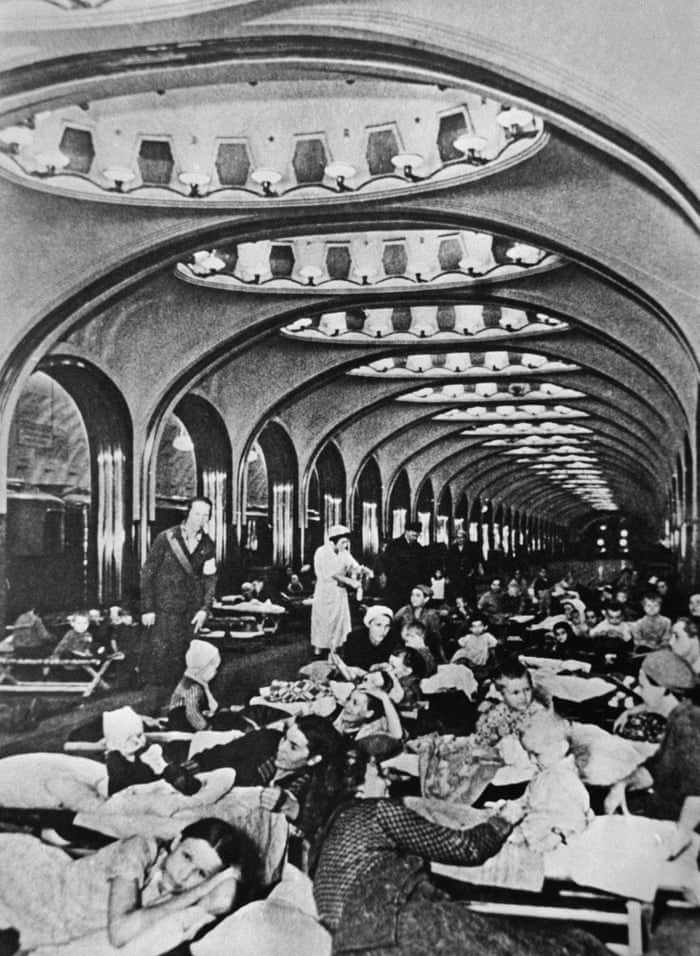Shosse Entuziastov Station
The design theme of the station is the struggle for freedom during Russia's history. Shosse Entuziastov station is decorated in various colors and shades of marble, with colors ranging from dark grey to yellows. Sculptures and pictures relating to revolutionary subjects adorn the walls. The sculpture at the end of the hall is titled "Flame of Freedom".
Elektrozavodskaya Metro Station
Named after the electric light bulb factory nearby, the ceiling is covered with six rows of circular incandescent inset lamps of which there were 318 in total. There are 12 marble bas-reliefs on the pylons highlighting the nation's struggle in the World War.
Komsomolskaya Metro Station
Komsomolskaya opened in 1935. The station has tall pillars faced with pinkish limestone and blue-grey marble and the floor is tiled with grey granite. The imposing Baroque ceiling, painting in yellow is decorated with eight mosaic panels of smalt and precious stones. The theme of the panels represent the Russian fight for freedom and independence throughout history.
 |
| Michelle |
Prospect Mira
Opened in January 1952. The station is designed using pylons faced with flared white marble, and are topped with ceramic bas-relief frieze made of floral elements. In the center are medallion bas-reliefs featuring different aspects in the development of agriculture in the Soviet Union. The station walls are laid with dark red Ural marble and the chessboard floor pattern is made of grey and black granite.
 |
| Very typical Russian grandmas |
 |
| Very typical Russian Lady |
Built in 1952, Novoslobodskaya is best known for its 32 stained glass panels, surrounded by an elaborate brass border. They are set into one of the station's pylons and illuminated from within. At the end of the platform is the mosaic entitled, "Peace Throughout the World".
Mayakovskaya Metro Station
This is considered one of the most beautiful stations in the system. Based on a Soviet futre as envisioned by the poet Mayakovsky, There are a total of 34 ceiling mosaics surrounded by filament lights, with the theme of "24 Hour Soviet Sky". Located 33 meters beneath the surface, the station became an air raid shelter during WWII. On the anniversary of the October Revolution on November 7, 1941, Joseph Stalin addressed a mass assembly of party leaders and ordinary Muscovites in the central hall of the station.
 |
| It is actually against the law to take pictures of the police but it just so happened that I was photographing the station when these strapping lads came walking through. Atleechna!! (Excellent) |
If you look closely, you can see around the outer edge by the lights, there are stars and hammer and sickles. You can see the hammer and sickle everywhere you look.

 |
| I can't find an actual date for this photo. |
Kievskaya Station
Opened in March 1954. It is dedicated to the friendship between the Russian and Ukrainian people and is named Kiev after the capital city of the Ukraine. This style of this station is socialist realism which corresponds with an ideology rather than an art form. On almost every picture Russian symbols can be found: the red flag complete with hammer and sickle in remembrance of the soviet past.
Kievskaya metro is located on the "ring" which is a line that runs in a circle. There are 6 lines that are straight-ish and pass through the "ring line". They go through one point of the ring and go out at the opposite end of the ring. This means that the stations on the ring have multiple platforms. The pictures below are also at the Kievskaya stop but on a different platform of the same station.
Ploshchad Revolyutsii Metro Station
The metro is decorated with 76 sculptures one cut into each corner of each column, arranged thematically moving from parents with their children to athletes, students to farmers, industrial workers to hunters to soldiers. There is also a frontier guard with a dog whose nose people rub for good luck.





























































No comments:
Post a Comment